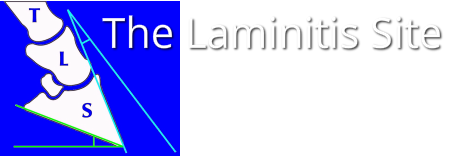What are the benefits and disadvantages of barefoot v shod for horses recovering from laminitis?
feet usually need frequent trimming during realignment - heels can grow 10 mm in 3 weeks, and shouldn't be lowered by much more than 10 mm, so trims usually need to be no more than 2 weeks apart initially until the feet are fully realigned.
the walls are not fully connected to the bone (and therefore skeleton), so weightbearing on the walls should be minimized. This is particularly important when an area of separation can be seen on the x-rays, as nothing in front of the area of separation is stable and therefore shouldn't bear weight at all. - the horse needs support directly beneath the pedal bone.
if the sole is thin but there is palmar rotation, i.e. heels need to come down, the only way to do this is to trim the bottom of the foot in 2 planes, impossible with shoes, no problem with well padded boots.
nearly all the penetrations we've seen have been in horses wearing shoes with no sole support (I have to say with the exception of the penetration we're working on at the moment, but she had casts fitted around pads with a hole cut out beneath the tip of P3 in the pads, giving P3 a hole to fall down into, which is exactly what happened. We think the only reason only 1 foot penetrated was because the hole in the pad on the other foot was badly placed and not beneath the tip of P3).
Some examples:
Horse&Hound Forum 2010
A 14 year old 16 hh mare had been suffering from laminitis for 10 weeks when she suddenly deteriorated and the pedal bone could be seen as a bulge in her sole. X-rays were taken and confirmed severe rotation in both back feet with around 1 mm of sole covering the pedal bone. Front feet were not affected. Imprints were fitted and eased her discomfort, after which pain was only seen when she walked out of the stable. On between 4 and 1 Bute a day, not tested for PPID (or insulin?). Mare described as always having sensitive/thin soles. 3 days after posting on a forum for help, the owner reported that the mare had been unable to put any weight on her worst foot, the bone had moved more and sunk and vet and farrier said there was no alternative but to PTS.
Lessons to learn:
X-rays should have been taken as soon as laminitis was suspected - ideally on the first day, and definitely within the first week - and the feet realigned and supported through the full solar surface.
Horses should not leave their area of confinement with wall to wall bedding until their feet are fully realigned, well supported through the full solar surface, and they are off of all pain relief.
Lifting a horse off of its soles will often reduce pain - but is also likely to leave the pedal bone unsupported, allowing actual solar penetration.
Shoes will load the walls - already disconnected from the bone - and not allow lowering of the heels but protection of sole depth in the front of the foot.
The cause of the laminitis must be identified as soon as possible and removed/treated/managed.
Although very limited, research by Panagiotopoulou et al. at the RVC that looked at the effects of a steel shoe v no shoe on one TB gelding when walking over a platform, found that "in all cases, the shod horse showed higher concentration of stresses on the P3 than the unshod condition, with the caveat that none of these differences were statistically tested."
Panagiotopoulou O, Rankin JW, Gatesy SM, Hutchinson JR
A preliminary case study of the effect of shoe-wearing on the biomechanics of a horse’s foot
PeerJ. 2016;4:e2164. doi:10.7717/peerj.2164

 RSS Feed
RSS Feed